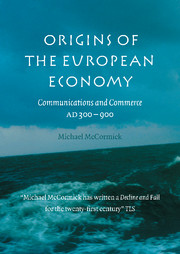Book contents
- Frontmatter
- Dedication
- Contents
- List of maps
- List of figures
- List of tables
- List of charts
- Preface
- List of abbreviations
- Commerce, communications, and the origins of the European economy
- PART I THE END OF THE WORLD
- PART II PEOPLE ON THE MOVE
- PART III THINGS THAT TRAVELED
- 10 Hagiographical horizons: collecting exotic relics in early medieval France
- 11 “Virtual” coins and communications
- 12 Real money: Arab and Byzantine coins around Carolingian Europe
- Things that traveled
- PART IV THE PATTERNS OF CHANGE
- PART V COMMERCE
- Appendices
- Bibliography
- Index
12 - Real money: Arab and Byzantine coins around Carolingian Europe
from PART III - THINGS THAT TRAVELED
Published online by Cambridge University Press: 05 February 2015
- Frontmatter
- Dedication
- Contents
- List of maps
- List of figures
- List of tables
- List of charts
- Preface
- List of abbreviations
- Commerce, communications, and the origins of the European economy
- PART I THE END OF THE WORLD
- PART II PEOPLE ON THE MOVE
- PART III THINGS THAT TRAVELED
- 10 Hagiographical horizons: collecting exotic relics in early medieval France
- 11 “Virtual” coins and communications
- 12 Real money: Arab and Byzantine coins around Carolingian Europe
- Things that traveled
- PART IV THE PATTERNS OF CHANGE
- PART V COMMERCE
- Appendices
- Bibliography
- Index
Summary
Actual coins deepen the documents. In 1955, a French scholar inventoried fifteen finds down to about 900. Since then, more Arab coins have come to light; further research has clarified the contents of certain finds and the circumstances of others. The evidence has tripled, even allowing for the removal of a few errors. A more recent overview emphasized that some Arab coinage moved into western Europe under the Carolingians, but that its pattern differed from the later Middle Ages: around 800, it maintains, both Spain and gold dinars played only a minor role, while Venice played the major one, with silver coinage coming from Africa and the Middle East. The documents suggest a first correction, for they emphasize dinars. Moreover, some European hoards of Arab money include Byzantine coins. They suggest that we should extend our investigation to these other tokens of Mediterranean wealth, even though they are almost absent from documents written outside Ravenna. The likelihood that Byzantine gold coins continued to circulate in Muslim Egypt at least into the early eighth century makes that extension imperative.
Coin discoveries first exploded in the nineteenth century. Old coins turned up as Europe catapulted into the industrial age, developing and building everywhere. The new railroads, with their gradients, bridges, and tunnels, disturbed soil and rocks deep along ancient and modern communication routes. A second wave of discoveries is just now under way, thanks to amateurs hunting for treasure with metal detectors, a decidedly mixed blessing.
- Type
- Chapter
- Information
- Origins of the European EconomyCommunications and Commerce AD 300–900, pp. 343 - 384Publisher: Cambridge University PressPrint publication year: 2002

